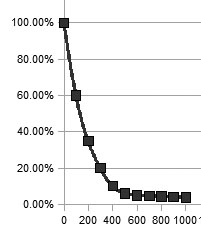From Shiro Kuma's Weblog by kumafr
In order to make myself clear I did a chart representing the exponential curve for the Error Tolerance Level (ETL). It helps to understand better what I tried to explain with my words.
In the diagram:
the abscissa (X) represents the number of repetitions (from 1 to 1000) and
the ordinate Y) represents the EL in percent (from 0% to 100%).
The more we repeat the movement and the smaller the EL. We strive for the perfect movement but we know that we will never reach it as perfection is of divine essence. Our goal is to reach an acceptable level of error that does not change the outcome of the fight, this is the ETL oe error tolerance level.
It is like the time paradox of the arrow shot at the target and never reaching it in Zeno’s problem (cf. Plato, Aristotle, Zeno). To the mathematician mind we will never reach the perfect movement; but to the warrior mind it is good enough.
Often in the dôjô and in life we want things to be so perfect that we don’t do them. The bujinkan is teaching us to act instead of thinking. Remember Watzlawick in “Munchausen pigtail” writing that action must precede reflection (thinking).
This is a path of action we have taken by entering a bujinkan dôjô not an intellectual one.
Don’t forget it (but don’t think too much about it).





 …
…